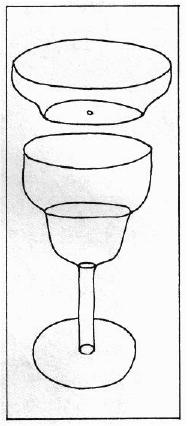National Depression Glass Association
Preserving America's Glass Manufacturing Heritage
Absinthe Stemware
by Bill Webster
Glass Review - March 1981
 The word absinthe originally meant wormwood and the liqueur called
absinthe was heavily laced with the oil of wormwood. It was developed
in Switzerland but found its greatest popularity in France during the
19th century. It was the next thing to pure dynamite as a beverage,
containing from 60% to 80% alcohol, and with the addition of the
wormwood not only became addictive, but produced hallucinatory
reactions in some people.
The word absinthe originally meant wormwood and the liqueur called
absinthe was heavily laced with the oil of wormwood. It was developed
in Switzerland but found its greatest popularity in France during the
19th century. It was the next thing to pure dynamite as a beverage,
containing from 60% to 80% alcohol, and with the addition of the
wormwood not only became addictive, but produced hallucinatory
reactions in some people.
Probably because of the high potency of the liqueur, the accepted method of drinking it was to pour a jigger into a small glass, place some sugar and cracked ice in a strainer, then pour water through the strainer into the glass. Thus cut, the liqueur became cloudy and was ready for consumption through a straw. This was good enough for the ordinary absinthe drinker, but the carriage trade wanted something with more class. Hence, the market for hand-blown crystal absinthe glasses similar to those in the illustration. The top piece with a tiny drip hole in its center replaced the less glamorous strainer and the ceremony of watching the water drip into the lower glass must have been delightful, providing the drinker could remember it afterward.
In 1908, probably due to the problems it created, Switzerland banned absinthe; U.S. made its importation illegal in 1912; France ruled it unlawful in 1916. A substitute liqueur, with none of the ill effects now replaces absinthe and is named after the man who first manufactured absinthe commercially - one M. Pernod.
If you are collecting glasses and this account inspires you to take another look around your basement or attic, keep one thing in mind ... if your search turns up a bottle of absinthe, don't drink it in any kind of glass.